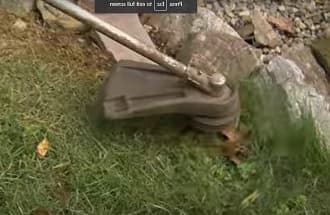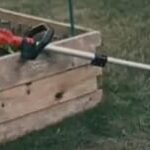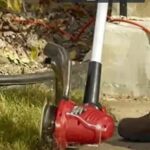As an Amazon Associate, this site earns commissions from qualifying purchases. For more information click here.
Everything is prepared and you are about to do some serious yard work, but now the weed eater will not start. This can be very frustrating and annoying, but not to worry. There are some steps you can take to fix your weed eater (or string trimmer) and get it running again. As you will see, the causes and solutions are straightforward.
The most common reasons why a weed eater will not start is a flooded engine or a clogged carburetor. The fuel tank might also be running low or the gas and oil mix ratio is wrong.
Flooded Engine
An engine gets flooded if the fuel is too rich. If the air filter is clogged for instance, the engine will not get enough air, the mix ratio cannot be obtained. The excess fuel can leak to the spark plug and other parts and cause it to flood.
Of course, if a weed eater does not start, you try again. And that makes it worse because the more you keep trying, the more flooding occurs. There is however, a simple way to fix this.
Solution
- Turn the weed eater switch on.
- Set choke to “off”.
- Grab the throttle and at the same time, pull the starter cord. This might take 8-10 pulls or more. It depends on how flooded the engine is.
- After several pulls you will see smoke. That is the excess fuel being burned off. Do not let go of the throttle.
- When the smoke has dissipated, you can release the throttle.
Related. Weed eater engine is flooded

Fuel Problems
A lot of the problems getting a weed eater to start are connected to the fuel. The most likely reasons are:
- Old fuel clogging the engine
- Not enough fuel to power the weed eater
- Wrong fuel mix ratio prevents the engine from starting
Solution
Open the tank and check how much fuel is in it. If the tank is almost empty, you need to add more fuel. But first give it a swish to make sure the fuel has not turned gummy. If the fuel swirls, add more
If the fuel has been in the tank for months and you haven’t used the machine, replace it. Old fuel loses efficiency and turns into a gum-like substance. If you stored the weed eater for winter with fuel, it will become gummy by spring. The only exception is if you added fuel stabilizer.
If you are going to buy a gas string trimmer for instance, you have to replace the fuel at least every 30 days if you are not going to use it regularly. Using old fuel is going to cause a lot of engine problems, so fresh fuel is ideal.
When adding fuel, follow the manufacturer recommended gas to oil mix ratio. Usually it is 50:1 or 40:1. Most weed eaters work with regular unleaded gas. But use only those with 10% or less ethanol and minimum 87 octane rating.
It also helps to have a quality string trimmer. With the Craftsman WS4200 trimmer, fuel is less likely to be a problem as it is well-designed.
Fuel Filter is Clogged
The fuel filter is responsible for keeping the fuel flowing steadily into the engine. It also keeps debris, dirt and other particles out of the engine fuel.
If the fuel filter is too clogged, only limited fuel will reach the engine. If it is filled with debris, this can cause additional engine damage.
Solution
Clean or replace the fuel filter. Most weed eaters have the fuel filter inside the fuel tank. If you open the tank you should see it there right on the fuel line. To remove the fuel filter you might have to take the fuel line out as well. The process differs so check your owner’s manual.
Check the fuel filter for signs of damage. You can try cleaning the filter and using it again, but most people just replace it. These are very affordable and at some point has to be replaced anyway.
Spark Plug Issues
If the spark plug is not working, the engine will not start. After the carburetor mixes fuel and air, the ignition generates current which the spark plug uses for fuel ignition. If this happens, either the spark plug is dirty or damaged.
Solution
Remove the spark plug and examine it for cracks. If it is just dirty, use a spark plug cleaner like ABN Pneumatic. You might have to use a scraper tool to clear off the deposits. For best results, clean the spark plug at the start of each season.
Put the spark plug back on after cleaning. If the engine still will not start, the spark plug is probably damaged. You can use a spark plug tester to check but if there are cracks, you might as well replace it.
Check your owner’s manual for what spark plug type to get. Once you have the new spark plug, install it and try the weed eater again.
Carburetor is Clogged
The carburetor mixes the fuel and air and allows you to adjust the engine speed. If the carburetor is clogged or damaged, the engine cannot function. If the engine overheats, stalls or stops working when you engage the throttle, there is a problem.
Solution
Most of the time, carburetor problems can be fixed by cleaning. This video shows you how to clean a carburetor, and the process is similar for most string trimmers. If you want a detailed guide, just keep reading.
In most weed eaters, the carburetor is nestled under the air filter. So you have to remove the air filter and its cover out first. Now that you have access to the carburetor, you can begin cleaning. You can use WD-40 to remove the grime.
It is also a good idea to buy a compatible carburetor rebuild kit. During the cleanup you might find some parts are worn out and need replacement. A kit includes gaskets and other parts that you might need so it makes sense to have one.
If cleaning or rebuilding with a kit does not work, the carburetor has been severely damaged. Your only option is to buy a new one. You can find it at the manufacturer’s official website or a third party that provides a compatible carburetor.
Clean the Spark Arrestor
If you look at a weed eater exhaust, there is a screen covering it. That is the spark arrestor and designed to keep sparks from getting out and causing a fire. It is an important safety feature and trimmers have this in some or another.
Solution
Prolonged use can clog the spark arrestor, filling it with carbon deposit. An imbalanced fuel mix can can cause clogging and render it unusable. Remove the screen and clean it as thoroughly as possible. If the screen is too dirty or damaged, get a replacement.
Blocked Air Filter
The air filter does two things: it prevents harmful particles from getting in the engine. Fuel contamination is problematic so this is crucial. Second, the filter facilitates the flow of clean air into the engine which is used to mix with the fuel.
These air filters get dirty with constant use, and one of the signs is a stalled engine. If the air filter is clogged, air cannot get into the engine. Without air, the carburetor cannot mix the fuel.
A dirty air filter also contaminates the engine. Instead of keeping debris out, the dirt is locked in. Both of these are enough to stop the engine from working.
Solution
Remove the air filter screws and take the filter out. Clean the filter with soapy water. If the filter is very dirty, leave it in a bowl of soapy water for a few minutes. Discard the dirty water and repeat if needed. Let the air filter dry before putting it back. If the engine still won’t run, you should replace the air filter.

I love the outdoors and all the tools for maintaining gardens, yards and lawns. The only thing I am more passionate about is sharing what I know about garden and outdoor equipment.


